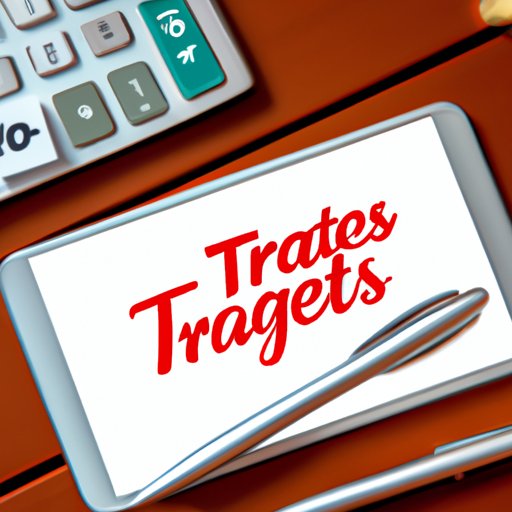
Introduction
The Internal Revenue Service (IRS) is responsible for collecting taxes from individuals and businesses in the United States. While paying taxes is an essential responsibility of every citizen, it can often be overwhelming and confusing. Many individuals may find themselves wondering: Can you make payments to the IRS? The answer is: Yes. There are several ways to make payments to the IRS, and this article will explore five easy options to guide you through the process.
5 Easy Ways to Make Tax Payments to the IRS
It’s essential to know that the IRS accepts various payment methods, including online payments, checks/money orders, credit/debit cards, wire transfers, and cash payments. Here are five easy ways to make tax payments to the IRS:
1. Online Payments
Online payments are the most convenient and efficient way to make tax payments to the IRS. The IRS offers several electronic payment options, including debit/credit card payments, electronic funds withdrawals, and online bill payments through your bank. You can make your payments electronically by visiting the IRS’s website and choosing the option that suits you best.
Pros: Online payments are fast, secure, and easy to process. You can pay your taxes from anywhere and at any time, and you don’t have to worry about losing your receipts or checks.
Cons: Online payments may require a processing fee that varies depending on the type of payment you’re making. Additionally, you may risk exposure of your sensitive information while making online payments.
2. Checks/Money Orders
Another way to make tax payments to the IRS is by sending them a check/money order. You can make the payment by mailing your check/money order to the IRS with the relevant tax documents. Make sure that you include your name, address, phone number, and social security number to ensure proper processing.
Pros: You don’t need to provide your bank account or credit card information to the IRS, reducing your risk of identity theft. Additionally, there are no processing fees involved in this method of payment.
Cons: The processing time for paper checks/money orders can take several weeks, increasing the likelihood of late payment penalties and interest accruals. Also, sending checks/money orders through the mail poses a risk of them getting lost or stolen.
3. Credit/Debit Cards
You can also make tax payments to the IRS using your credit/debit cards. The IRS collaborates with third-party processors who accept credit/debit card payments on their behalf. You can make credit/debit card payments online, by phone, or in person through approved vendors.
Pros: Credit/debit card payments are easy and convenient to make and can be processed in real-time. They’re also an attractive option if you’re short on cash.
Cons: There’s a convenience fee involved in using this payment method, which can range from 1.87% to 3.93% of the total amount you owe. Additionally, interest rates on credit cards, if not paid off timely, can lead to more financial burdens over time.
4. Wire Transfers
If you prefer to make payments directly through a bank or third-party payment processor, you can issue a wire transfer. Complete the wire transfer instructions and give them to your bank, who will wire the funds to the IRS.
Pros: Wire transfers are convenient and fast and offer immediate payment processing.
Cons: You may have to pay fees charged by the intermediary bank, which can add up to an additional expense. Also, wire transfers can be tricky to execute, and mistakes can lead to delays and additional costs.
5. Cash Payments
Cash payments are generally not recommended; however, it is an option in certain situations. The IRS allows cash payments at participating 7-Eleven or ACE Cash Express stores.
Pros: This payment method is quick, anonymous, and can be processed instantly.
Cons: There are several restrictions to note: cash payments are limited to $1,000 per day or per transaction, and handling charges may apply. Additionally, cash payments are prone to getting lost or stolen, and there’s no way to verify payment.
Exploring Your Options for Paying the IRS: A Guide
Another essential step to take when paying taxes is to explore different options available and determine which one is best suited for your situation. Here are some options:
1. Installment Agreements
If you can’t pay your taxes in full, you can apply for an installment agreement with the IRS. This is a payment plan that allows you to make monthly payments over time until you have paid off your tax debt.
Tips: Be sure to explore all installment plan options available and choose the plan that works best for you. You can set up payment plans online, or use the IRS’s “Apply Online for a Payment Plan tool” to apply. Consider the fees involved, including interest and penalties for late payments.
2. Offer in Compromise
If you’re unable to pay your taxes in full, and you can demonstrate significant financial hardship, you may qualify for an Offer in Compromise. This option allows you to negotiate with the IRS to settle your tax debt for less than the full amount owed.
Tips: Keep in mind that an Offer in Compromise is often the hardest option to qualify for, and the process can be lengthy and time-consuming. You’ll need to provide documentation to the IRS to support your application. Work with a tax professional who can help you determine whether this is the best option and can guide you through the application process.
3. Tax Relief
If you’re experiencing significant financial hardship, you may also qualify for tax relief through the IRS. The IRS offers several tax relief programs, such as currently not collectible status, innocent spouse relief, or hardship release.
Tips: Be sure to explore all of the tax relief programs available to you and determine which one best suits your needs. A tax professional can help you determine if you qualify, how to apply, and what documentation is needed.

Paying Your Taxes: How to Navigate the IRS Payment Process
Whether you choose to pay your taxes online or through other methods like checks/money orders, navigating the IRS payment process can seem challenging. Here’s a step-by-step process to guide you:
Step 1: Review Your Information
Before making your payment, review your tax documents and ensure that all necessary information is included, such as your name, social security number, and tax year information.
Step 2: Choose Your Payment Method
Choose the payment method that best suits your needs and budget. If you’re making an online payment, use the IRS’s website and select the payment option that works best for you. If you’re paying by check/money order, ensure that it’s payable to the “United States Treasury.”
Step 3: Verify Payment Amount
Confirm the amount of the payment you’re making, including any interest or penalties that may apply. Make sure that you’re making the correct payment amount to avoid any issues or delays.
Step 4: Keep Records and Receipts
After making your payment, keep records of your payment, including receipts and copies of checks/money orders. Documentation will be essential if you need to resolve any payment disputes or issues with the IRS.
Breaking Down the Tools Available for Making IRS Payments
With the IRS’s emphasis on electronic filing and payment, online payment tools have become more popular. Here’s a breakdown of several tools you can use to make payments to the IRS online:
1. IRS Direct Pay
IRS Direct Pay is the IRS’s free online tool that allows individuals to make a direct payment from their checking or savings accounts. You can access it through the IRS’s website.
2. Electronic Federal Tax Payment System (EFTPS)
EFTPS is a free, secure online payment system operated by the IRS. You can use it to make federal tax payments, including income, payroll, and excise taxes.
3. Debit or Credit Card Payments
The IRS partners with several authorized payment processors who facilitate debit/credit card payments. You can choose the payment processor that best suits your needs and budget.
Maximizing Your Convenience and Security When Paying the IRS
Regardless of which option you choose to make tax payments to the IRS, it’s crucial to prioritize security and convenience. Here are some tips for maximizing both:
1. Choose Secure Payment Methods
Use payment methods that are secure and encrypted. Avoid sending cash through the mail or making payment over unsecured networks or public Wi-Fi.
2. Keep Records and Receipts
Keep a record of your payment receipts and supporting documentation. Store them in a safe and secure location to refer to in the future.
3. Pay on Time
Avoid late payment penalties and interest accruals by submitting your payment by the deadline. IRS website can assist you with information and deadlines.
The Lowdown on Making IRS Payments: What You Need to Know
The IRS offers several payment methods to make paying taxes more accessible for taxpayers. You can pay online, by check/money order, credit/debit cards, wire transfers, or cash payments. While exploring different options, it’s essential to determine which method works best for you. Additionally, navigating the IRS payment process may seem challenging, but by following our step-by-step instructions, you can avoid any potential issues or delays. Electronic payment tools are becoming increasingly popular, and online payments are becoming the most convenient and efficient way to send payments. Regardless of which payment method you choose, prioritize convenience and security to ensure a seamless payment process.
Conclusion
Paying taxes to the IRS can be a challenging and overwhelming process for many. Still, with the different options available, making payments can be stress-free and manageable. From installment agreements to tax relief programs to online payment tools, you can choose the method that works best for you. Regardless of which payment method you choose, prioritizing convenience and security by keeping records, making timely payments, and choosing secure payment methods can make the payment process smoother. Remember, seek advice and guidance from tax professionals who can offer expert advice tailored for individual needs.
Additional Resources:
The IRS’s website offers an abundant amount of information for people seeking to make tax payments. They have resources and tools available to help you choose which payment method that works best for you and assistance in navigating the payment process.





